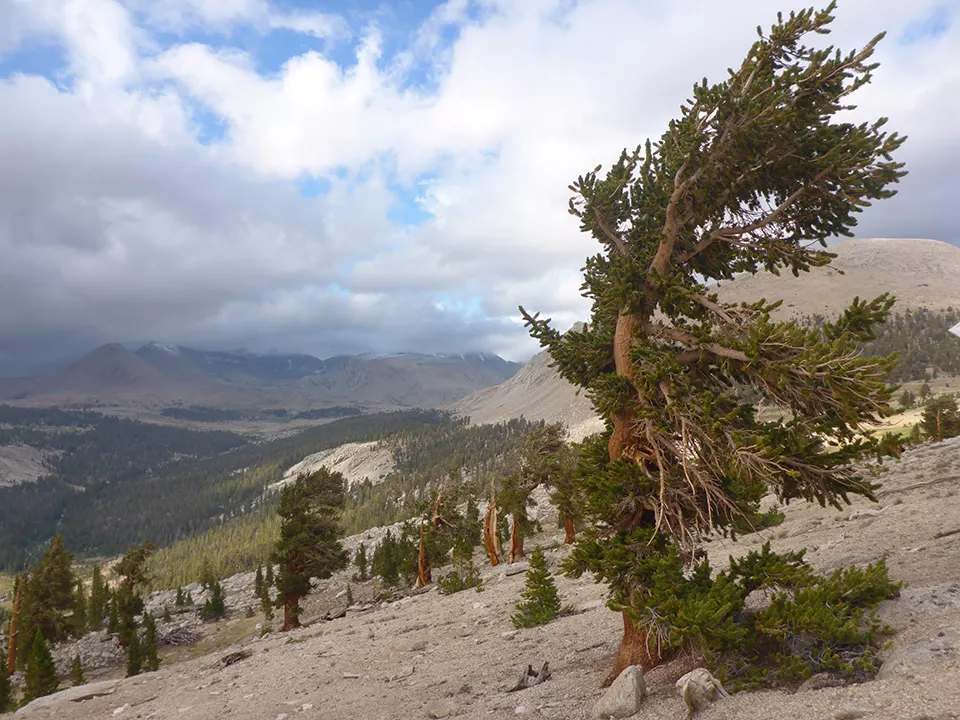
Subalpine forest density
Today’s subalpine forests in the Sierra Nevada are denser – with more small trees and fewer large trees -- than in the early decades of the 20th century.
Subalpine forests in the Sierra Nevada Mountains occupy the highest elevations (7,500 to 11,000 feet) – up to the treeline, where cold temperatures do not support tree growth. Forests at these elevations, which are relatively free from forest management and timber harvesting influences, provide a clearer picture of climate change impacts. Subalpine forests in the Sierra Nevada Mountains occupy the highest elevations. For more information, download the Subalpine Forest Density chapter.
Trees in subalpine elevations must be able to withstand cold temperatures, severe wind, and a short growing season. They regulate snowmelt and stream flow, and provide habitat and food for birds and mammals. Foxtail pine (below), mountain hemlock, whitebark pine, and occasionally western white pine, limber pine, and western juniper are examples.
Credit: National Park Service
What does the indicator show?
- The density of small trees increased by 62 percent while large tree densities decreased by 21 percent in North and Central Sierra Nevada subalpine forests between the 1930s and the late 2000’s.
- Increased density of small trees has also been observed in forests and woodlands throughout California.
Why is this indicator important?
- Changes at subalpine elevations could adversely impact the ecology of the Sierra Nevada. Younger and smaller trees cannot provide the same functions performed by large trees. Large trees store considerable amounts of carbon, provide soil nutrients, serve as barriers to water runoff, and shelter birds and other wildlife.
- Subalpine forests have historically been sparse, without enough accumulated dead, woody residue on the forest floor to fuel and spread wildfires. Thus, fires in the subalpine zone were historically infrequent and isolated. Recently, wildfires have been occurring at increasingly higher elevations in the Sierra Nevada. An increasing number of smaller trees provides fuel that could ultimately lead to larger and more frequent fires.
- Denser forests and warming temperatures could also make conditions more favorable for insect outbreaks and disease, leading to increased tree deaths.
What factors influence this indicator?
- Over the past several decades, warming temperatures and reduced snowpack in the region have made conditions more favorable for smaller young trees, and less favorable for large trees which have a higher water demand.
New information presented in the 2022 report is summarized below:
- Treelines in almost 90 percent of Northern Hemisphere forests studied shifted to higher elevations between 1901 and 2018, but at a rate slower than expected from warming alone. Precipitation has been a more important factor: in the temperate region, a combination of warmer temperatures and higher autumn precipitation accelerated rates, whereas wetter springs reduced them.
- Subalpine forests can expand into higher elevations only if the conditions are favorable for seedlings to survive. Physical features, such as boulders, shrubs and krummholz trees (vegetation stunted and deformed by harsh conditions), protect seedlings and favor growth and establishment. On the other hand, “hotter drought” could have the opposite effect.
Additional Resources
- UC Berkeley, Weislander Vegetation Type Mapping
- US Forest Service, Forest Inventory and Analysis
